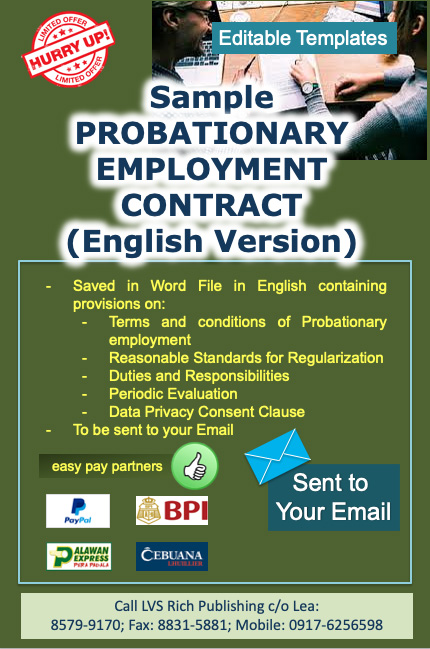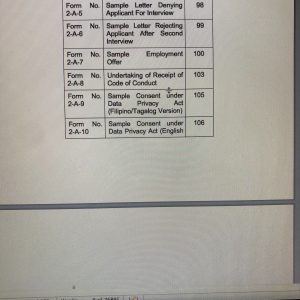
Contract for Probationary Employment Daily Paid Employee – Soft Copy Editable Template
₱1,595.00
CONTRACT FOR PROBATIONARY EMPLOYMENT
SOFT COPY DESCRIPTION
This is a soft copy template saved in Word File and editable in Word Document.
This contains the sample terms, conditions, clauses, and provisions of the contract described.
See the Description below to view the Contents of this soft copy template.
A probationary employee is one who, for a given period of time, is being observed and evaluated to determine whether or not he is qualified for permanent employment.
A probationary appointment affords the employer an opportunity to observe the skill, competence and attitude of a probationer.
The word probationary, as used to describe the period of employment, implies the purpose of the term or period (Enchanted Kingdom, Inc. vs. Verzo, G.R. No. 209559, December 09, 2015).
While the employer observes the fitness, propriety and efficiency of a probationer, to ascertain whether he is qualified for permanent employment, the probationer, at the same time, seeks to prove to the employer that he has the qualifications to meet the reasonable standards for permanent employment. (41Escorpizo v. University of Baguio, 366 Phil. 166, 175-176 (1999).)
Read more..
The concept of probationary employment was, thus, introduced for the benefit of the employer to provide him with ample time to observe and determine whether a newly hired employee has the competence, ability and values necessary to achieve his objectives.
Probationary employment shall not exceed six (6) months from the date the employee started working, unless it is covered by an apprenticeship agreement stipulating a longer period. The services of an employee who has been engaged on a probationary basis may be terminated for a just cause or when he fails to qualify as a regular employee in accordance with reasonable standards made known by the employer to the employee at the time of his engagement. An employee who is allowed to work after a probationary period shall be considered a regular employee.
Employers should be careful in crafting probationary employment since any ambiguity shall be resolved in favor of labor (Art. 4, Labor Code). Such favor means regular employment since it offers a better status of the employee.
It bears noting as well that an employee who was not informed of the reasonable standards for regular employment shall be deemed as regular from day one. Thus, it makes better sense when these standards are included in the contract.
As held in Buiser vs. Leogardo, an probationary employment may also be extended upon mutual consent of the parties. This means that instead of terminating an employee who failed the trial period he is given a chance. Now, to avoid ambiguity, the employment contract should already provide a clause for this just like what is found in this template.
A sample contract will help employers to overcome the technicalities of this form of employment. This template is easy to edit using the Word application. This version is using MS Office 365.
Salient points of this template are:
1. Parties
2. Whereas Clause
3. Commencement of probationary employment
4. Extension Clause
5. Termination of Employment
6. Place of Posting
7. Duties and responsibilities clause
- Reasonable Standards Metrics
i. Performance
ii. Punctuality/Attendance
iii. Behavior
iv. Teamwork
v. Initiative - Periodic Evaluation
- Passing Clause
8. Compensation and Benefits
9. Office Decorum
10. Non-compete Clause
11. Training Expenses
12. Data privacy consent clause
close
Related Products
-
Human Resource Forms, Notices and Contracts Vol. 2
2.90 out of 5₱845.00Title: Human Resource Forms, Notices & Contracts Made Easy Vol. 2
Procedures in labor law and social legislation are perilous terrain to navigate most especially to new practitioners in the field of employee relations. Reading and under-standing the provisions of law may not be enough since the actual implementation of the legal requirements will make or break any management decision.
It takes a combination of legal knowledge and experience in the field to safely execute the functions in employee relations. Thus, authors in this work discuss not only the legal principles in labor law but also share useful or practical forms to use in various situations.
By showing the forms to use, the practitioner is enlightened on the purpose and principles behind relevant labor law provisions. The risk involved in executing the management decision may be reduced once the principles and applications are put proper use.
Scroll down for more information
-
Employment Contracts Templates Soft Copy (English and Filipino/Tagalog)
0 out of 5EMPLOYMENT CONTRACTS TEMPLATES DESCRIPTION
Employment contracts in the Philippines should be crafted in accordance with rules to ensure compliance with legal requirements.
This is saved in a single file in Word (Arial Font using sizes 12, 14, and 20). Buyers will receive the file through email from LVS’ gmail account. There will be price increase for this product soon.
Alert!: If you were able to purchase any of our soft copy products in the past please double-check that they are not part of these templates. This product is indivisible and individual soft copy templates previously purchased cannot be deducted from the price.
This product, Employment Contracts Templates (English and Filipino), contains 40+ samples or templates of various employment contracts used in the Philippines such as:
- Probationary
- Regular
- Casual
- Project
- Seasonal
- Fixed-Term or Fixed-Period, and
- Part-Time
Read more..
Some sample templates contain show formats that incorporate provisions on:
- Data Privacy Consent Clause
- Discipline
- Reference to Job Description
- Benefits
- Place of Work
- Shift
- Performance Metrics
- Decorum/Uniform
- Shift, etc.
close
Scroll down for more information
₱3,995.00₱3,900.00 -
Guide to Valid Dismissal of Employees 2nd Edition
2.57 out of 5₱785.00Title: Guide to Valid Dismissal of Employees 2nd Edition
Guide to Valid Dismissal of Employees 2014 Edition contains updated HR literature on terminal laws, rules and regulations including 2013 cases and other newly establishment doctrines and principles. The best-selling first edition of the book got even better with discussion of relevant provisions on retirement in relation to employee dismissal, rule on separation pay when dismissal is valid, preventive suspension , just causes, authorized causes, termination due to disease, bona fide suspension of operations and other related principles.
This book will prove helpful to all HR practitioners and professionals on employee or labor relations.
Scroll down for more information
-
Guide To Valid Dismissal Of Employees (The HR Practitioner’s Handbook)
2.86 out of 5Title: Guide To Valid Dismissal Of Employees (The HR Practitioner’s Handbook)
The book by Atty. Elvin B. Villanueva provides a refreshing and analytical insight on the matter with a twist of Human Resource outlook. His works, the HR Guide Series, which includes the “Guide to Valid Dismissal of Employees” and the “Guide on Employee Compensation and Benefits,” provide a compelling lineup of various topics on labor and human resources.
Scroll down for more information
₱400.00₱320.00 -
Salary & Benefit Adjustment Agreement (in Filipino / English) – Soft Copy Editable Template
₱750.000 out of 5 -
Human Resource Forms, Notices and Contracts Vol. 1
2.49 out of 5₱499.75Title: Human Resource Forms, Notices & Contracts Made Easy
This book provides 157 samples of employment contracts (probationary, seasonal project and casual), notices to explain covering various offenses, actual notices of dismissal, suspension and warning, among others. All the sample templates are written in English.
The forms used on this book are very important for HR practitioners as they are the ones needed in communicating to employees the terms of employment and due process. They are important evidentiary documents as well in case disputes on dismissal, employment benefits and other matters involving employer-employee relationship reach the labor courts.
These sample forms were designed following the principles laid down in the Labor Code, as amended as well as recent labor jurisprudence. Important principles on just causes of dismissal, five-day notice rule on notice to explain, preventive suspension and the conduct of hearing/conference prior to dismissal are also discussed here.
This book will help HR practitioners in discharging their role as the hub for the maintenance of industrial peace and harmony. Not only that this will help avoid costly mistakes in the event of labor disputes but will also help express the policies and principles of company.
The English forms and templates contained in this book are listed below.
Scroll down for more information
Pages
I………. Introduction ……………………………………………………. 1
II……… Chapter I: Pre-hiring forms ………………………………. 3
A….. Sample Application Form …………………………. 5
B….. Sample Application Letter by Employee ……. 21
C….. Employment Checklist …………………………….. 23
III…….. Chapter II: Contracts at point of hiring …………….. 27
A….. Employment Contracts ……………………………. 27
B….. Contract for Probationary Employment ………. 45
C….. Contract for Regular Employment …………….. 69
D….. Contract for Casual Employment ………………. 75
E….. Contract for Project Employment ……………… 85
F….. Contract for Seasonal Employment …………… 96
G…. Contract for Fixed Term Employment ………. 105
H….. Contract for Part Time Employment ………… 113
I…… Transfer of Employees …………………………… 121
IV…….. Chapter III: Forms Used During Employment ….. 125
A….. Notices to Explain ………………………………… 129
Sample notices to explain (where imposable penalty is a warning) for the following offenses 131
i…… Violation of company policies on …………………… 132
1….. General Cleanliness ……………………………… 132
2….. Littering ………………………………………………. 133
3….. Smudging ……………………………………………. 134
4….. Disorderly Filing ……………………………………. 135
5….. Designated dining areas ………………………… 136
ii….. Attendance …………………………………………………. 138
1….. Unauthorized undertime ………………………… 138
2….. Violation of coffee break schedule ………….. 139
3….. Violation of lunch break schedule …………… 140
4….. Abandoning post ………………………………….. 141
iii…. Unauthorized absences ………………………………… 142
1….. Absence without leave (AWOL) ………………. 142
2….. Failure to give notice for sickness ……………. 144
iv…. Punctuality/Time-keeping …………………………….. 146
1….. Tardiness …………………………………………….. 146
2….. Failure to log-in ……………………………………. 148
3….. Failure to log-out ………………………………….. 149
v….. Knowingly punching timecard or logging in attendance for other employees 150
vi…. Unauthorized alteration made on one’s timecard or attendance sheet 151
vii… Unauthorized alteration made on other’s timecard with consent of such employee 153
viii.. Unauthorized alteration made on other’s timecard without the consent of such employee 154
ix…. Unauthorized removal of one’s timecard or attendance sheet 155
x….. Unauthorized removal of another’s timecard or attendance sheet 157
xi…. Unauthorized concealment of one’s timecard or attendance sheet 158
xii… Unauthorized concealment of another’s timecard or attendance sheet 159
xiii.. Intentional destruction of one’s timecard or attendance sheet 161
xiv… Intentional destruction of another’s timecard or attendance sheet 162
xv…. Dress Code ………………………………………………….. 164
1….. Without uniform ……………………………………. 164
a….. Reporting for work not in prescribed dress code 164
2….. With Uniform ………………………………………… 165
a….. Reporting for work not in prescribed uniform (barong or blouse) 165
b….. Reporting for work not in prescribed uniform (pants or skirt) 167
c….. Reporting for work not in prescribed uniform (blazer) 169
xvi… Identification card ……………………………………….. 171
1….. Failure to wear ID card ………………………….. 172
2….. Refusal to wear ID card ………………………….. 173
3….. Deliberate destruction of ID card …………….. 175
4….. Deliberate mutilation of ID card ……………… 176
5….. Alteration of entries in the ID card …………… 176
6….. Concealment of one’s ID card ………………… 177
7….. Concealment of another’s ID card …………… 179
8….. Unauthorized and improper use of ID card .. 180
xvii.. Loitering …………………………………………………….. 182
1….. Loitering in unrestricted area ………………….. 182
2….. Loitering in restricted area ……………………… 183
xviii. Insubordination ……………………………………………. 184
1….. Refusal to subject oneself to annual physical examinations 184
2….. Refusal to subject oneself to executive checkup 186
3….. Refusal to abide by auditing procedure ……. 187
4….. Refusal to abide by security and safety regulations 188
5….. Refusal to transfer to another assignment …. 190
6….. Refusal to perform one’s task …………………… 191
7….. Refusal to render overtime work ………………. 192
8….. Refusal to report for holiday work …………….. 194
9….. Refusal to issue disciplinary action to subordinate 195
10… Refusal to obey lawful orders of Superior ….. 196
11… Refusal to give information in a company investigation 198
Sample notices to explain (where imposable penalty is suspension) 199
i…… Attendance …………………………………………………. 202
1….. Unauthorized undertime ………………………… 202
2….. Knowingly punching timecard or logging in attendance for other employees 204
ii….. Insubordination ……………………………………………. 205
1….. Refusal to transfer to another assignment …. 205
iii…. Willful breach of trust (with mitigating circumstance) 207
1….. Misappropriation of fund ………………………… 207
Sample notice to explain (where imposable penalty is dismissal) 209
1….. Notice issued for abandonment of work ……. 211
2….. Notice issued for willful breach of trust …….. 214
Sample notice to explain (where imposable penalty is dismissal with preventive suspension) 216
1….. Notice to explain for Serious Misconduct with preventive suspension 211
2….. Notice to explain for offense involving Willful Breach of Trust 214
Sample notice of hearing/conference ………………………. 222
– Instances where hearing is not necessary ………. 224
– Tips in conducting the hearing/conference …… 225
1….. Hearing for offense involving Willful Breach of Trust 228
2….. Hearing for offense involving serious misconduct 229
B….. Notice imposing disciplinary action (warning) ….. 231
i…… Violation of company policies on …………………… 233
1….. General Cleanliness ……………………………… 233
2….. Littering ………………………………………………. 234
3….. Smudging ……………………………………………. 235
4….. Disorderly Filing ……………………………………. 237
5….. Designated dining areas ………………………… 238
ii….. Attendance …………………………………………………. 240
1….. Unauthorized undertime ………………………… 240
2….. Violation of coffee break schedule ………….. 241
3….. Violation of lunch break schedule …………… 243
4….. Abandoning post ………………………………….. 245
iii…. Unauthorized absences ………………………………… 246
1….. Absence without leave (AWOL) ………………. 246
2….. Failure to give notice for sickness ……………. 248
iv…. Punctuality/Time-keeping …………………………….. 251
1….. Tardiness …………………………………………….. 251
2….. Failure to log-in ……………………………………. 253
3….. Failure to log-out ………………………………….. 254
v….. Knowingly punching timecard or logging in attendance for other employees 255
vi…. Unauthorized alteration made on one’s timecard or attendance sheet 257
vii… Unauthorized alteration made on other’s timecard with consent of such employee 258
viii.. Unauthorized alteration made on other’s timecard without the consent of such employee 260
ix…. Unauthorized removal of one’s timecard or attendance sheet 262
x….. Unauthorized removal of another’s timecard or attendance sheet 263
xi…. Unauthorized concealment of one’s timecard or attendance sheet 265
xii… Unauthorized concealment of another’s timecard or attendance sheet 266
xiii.. Intentional destruction of one’s timecard or attendance sheet 268
xiv… Intentional destruction of another’s timecard or attendance sheet 269
xv…. Dress Code ………………………………………………….. 271
1….. Without uniform ……………………………………. 271
a….. Reporting for work not in prescribed dress code 271
2….. With Uniform ………………………………………… 272
a….. Reporting for work not in prescribed uniform (barong or blouse) 272
b….. Reporting for work not in prescribed uniform (pants or skirt) 274
c….. Reporting for work not in prescribed uniform (blazer) 277
xvi… Identification card ……………………………………….. 278
1….. Failure to wear ID card ………………………….. 278
2….. Refusal to wear ID card ………………………….. 280
3….. Deliberate destruction of ID card …………….. 281
4….. Deliberate mutilation of ID card ……………… 283
5….. Alteration of entries in the ID card …………… 285
6….. Concealment of one’s ID card ………………… 287
7….. Concealment of another’s ID card……………. 288
8….. Unauthorized and improper use of ID card .. 290
xvii.. Loitering …………………………………………………….. 293
1….. Loitering in unrestricted area ………………….. 293
2….. Loitering in restricted area ……………………… 294
xviii. Insubordination ……………………………………………. 296
1….. Refusal to subject oneself to annual physical examinations 297
2….. Refusal to subject oneself to executive checkup 298
3….. Refusal to abide by auditing procedure ……. 300
4….. Refusal to abide by security and safety regulations 301
5….. Refusal to transfer to another assignment …. 303
6….. Refusal to perform one’s task …………………… 305
7….. Refusal to render overtime work ………………. 307
8….. Refusal to report for holiday work …………….. 308
9….. Refusal to issue disciplinary action to subordinate 310
10….. Refusal to obey lawful orders of Superior ….. 312
11….. Refusal to give information in a company investigation 313
C….. Notice imposing disciplinary action (suspension). 315
i…… Attendance …………………………………………………. 315
1….. Unauthorized undertime ………………………… 315
2….. Knowingly punching timecard or logging in attendance for other employees 317
ii….. Insubordination ……………………………………………. 318
1….. Refusal to transfer to another assignment …. 318
iii…. Willful breach of trust (with mitigating circumstance) 320
1….. Misappropriation of funds ………………………. 321
D….. Notice of Dismissal ………………………………………. 324
i…… Notice of Dismissal for Abandonment ………. 324
ii….. Dismissal Notice for Serious Misconduct ….. 330
iii…. Dismissal Notice for Willful Breach of Trust.. 341
V….. Note on the next Volume/s of HR Forms, Notices and Contracts Made Easy 346
-
Employee Leave Benefits
2.57 out of 5₱99.75Title: Employee Leave Benefits
Relatively new laws have been passed such as the ten (10)-day VAW-C leave for victims of violence and the recently enacted two (2)-month gynecological leave.
The author explain these benefits in interesting fashion and easy-to- read format. Likewise, he discusses important issues on Paternity. Solo Parent’s and Service Incentive Leave Benefits, among others.
Scroll down for more information
-
HR Forms, Notices and Contracts 1 Soft Copy Version (150+ Templates in Editable Word)
0 out of 5₱8,495.00Forms, Notices and Contracts
Soft Copy Version (Word File only – Saved as Single File)Alert!: If you were able to purchase any of our soft copy products in the past please double-check that they are not part of these templates. This product is indivisible and individual soft copy templates previously purchased cannot be deducted from the price.
Scroll Down to see the Table of Forms or list of Forms
Read more..
Based on the book Human Resource Forms, Notices & Contracts Volume One
Features:
- Editable in Word file (Saved as one file “HR Forms Volume 1 Soft Copy”)
- Fonts Used: Arial, Book Antiqua, Garamond
- With separate file showing instructions on How to Use and Navigate the HR Forms
- Product will be sent to Buyer’s Email Account from LVS’ gmail account.
- Over 150 Sample Forms such as:
- Employment Contracts (some with Data Privacy Consent Clause)
Regular
Probationary
Casual
Seasonal
Fixed-Term
Part-Time - Consent under Data Privacy Act
- DOLE Mandatory Policies
- Drug-Free Workplace
- HIV/AIDS
- Hepatitis B
- Tuberculosis
- Anti-Sexual Harassment
- Acknowledgment Receipt of Personal Protective Equipment (PPE)
- Authority to Deduct (Debt)
- Notices to Explain
- Notices of Hearing/Conference
- Notice of Suspension
- Preventive Suspension
- Extension of Preventive Suspension
- Termination Notice
- Extension of Preventive Suspension
- Application Form
- Employment checklist, etc.
- Acceptance of Resignation
- Acceptance of Resignation with Pending Case (Graceful Exit)
- Clearance Form
- Release, Waiver and Quitclaim
- Many more!
close
Scroll down for more information (Table of Forms)
- Editable in Word file (Saved as one file “HR Forms Volume 1 Soft Copy”)
-
Solutions on Wage Order and Minimum Wage 2nd Ed.
2.79 out of 5₱525.00Title: Solutions and Remedies on Wage Order and Minimum Wage
The book is designed as easy reference for HR Practitioners, Business Owners, Managers, and Expats who deal with Filipino labor.
Philippine law requires compliance by employers with minimum wages and benefits. It is simplistic to see this as mere implementation of labor rules. It is often more complicated than it seems.
This work guides readers on proper perspective, and practical knowledge in the tortuous highway of labor compliance. The discussion is served in no-frills platter as topics are presented in direct fashion and clear explanation.
This edition features Wage Order No. NCR-20 in the NCR. The book provides highlights on regional minimum wage, nature of wage order, wage or special group of workers (handicapped, paid by results, etc.), coverage and exemptions, CTPA, BMBE rules, wage distortion and how to correct it, salaries above minimum (creditable rule), across-the-board increases, and other interesting and important concepts.
This work can be a good tool in understanding the principles and doctrines in wage orders, irrespective of the rates applicable.
Scroll down for more information
-
Guide on Employee Compensation and Benefits Vol. 2
2.49 out of 5₱475.00Title: Guide on Employee Compensation and Benefits Vol. 2
Just how much should the company give as bonus? Just how many months of bonus should the company give without violating the law? If the company pays Christmas Bonus is it still required to pay 13th month pay? How about 14th and 15th month pay, should the company pay them also?
These are some of the perplexing questions that a typical HR practitioner encounters in his work. Most often, it is resolved in favor of the employees resulting in increased manpower cost on the part of the company.
The rules on 13th month pay and Christmas Bonus are discussed in this book. When to pay them and when not to are explained using the law and jurisprudence. Companies are not required to pay 14th, 15th month pay, and so forth, unless they are stipulated already in the CBA or any contract for that matter. But they are not legally mandated benefits.
How about productivity incentive bonuses, signing bonus, etc.? This book also offers explanation why some should be paid and the rest should not be.
Then comes the issue on leaves. Question like is there such thing as vacation leave in the Labor Code? Why can’t I find it? There is none because the Labor Code only provides for service incentive leave. There are other leave benefits discussed in this work like paternal, paternity and for women who are victims of violence.
This book also deals with issues on
- employee cash bonds, deposits
- authorized deductions
- the rules on employee compensation for disability, sickness, etc.
Scroll down for more information

















